Design of a Compact Multiband Monopole Antenna with MIMO Mutual Coupling Reduction
Abstract
:1. Introduction
2. Design of Antenna Structure
2.1. The Compact Multiband Monopole Antenna
2.2. MIMO Antenna Mutual Coupling Reduction
3. Antenna Implementation and Measurement Results
3.1. The Compact Multiband Monopole Antenna
3.2. MIMO Mutual Coupling Reduction
3.3. Envelope Correlation Coefficient (ECC)
3.4. Channel Capacity Loss (CCL)
4. Comparative Analysis
5. Conclusions
Author Contributions
Funding
Institutional Review Board Statement
Informed Consent Statement
Data Availability Statement
Conflicts of Interest
References
- Khorov, E.; Levitsky, I.; Akyildiz, I.F. Current Status and Directions of IEEE 802.11be, the Future Wi-Fi 7. IEEE Access 2020, 8, 88664–88688. [Google Scholar] [CrossRef]
- 5G-Americas Advanced Antenna Systems for 5G White Paper. Available online: https://www.5gamericas.org/advanced-antenna-systems-for-5g/ (accessed on 13 August 2024).
- Farasat, M.; Thalakotuna, D.N.; Hu, Z.; Yang, Y. A Review on 5G Sub-6 GHz Base Station Antenna Design Challenges. Electronics 2021, 10, 2000. [Google Scholar] [CrossRef]
- Kolangiammal, S.; Balaji, L.; Mahdal, M. A Compact Planar Monopole UWB MIMO Antenna for Short-Range Indoor Applications. Sensors 2023, 23, 4225. [Google Scholar] [CrossRef] [PubMed]
- Kempanna, S.B.; Biradar, R.C.; Ali, T.; Jhunjhunwala, V.K.; Soman, S.; Pathan, S. A Compact Slotted UWB Antenna Based on Characteristics Mode Theory for Wireless Applications. Designs 2023, 7, 141. [Google Scholar] [CrossRef]
- Zhu, J.; Eleftheriades, G.V. A Simple Approach for Reducing Mutual Coupling in Two Closely Spaced Metamaterial-Inspired Monopole Antennas. IEEE Antennas Wirel. Propag. Lett. 2010, 9, 379–382. [Google Scholar] [CrossRef]
- Haskou, A.; Pesin, A.; Le Naour, J.Y.; Louzir, A. Compact, Two-Port, Slot, Antenna for Dual-Band WiFi 2 × 2 MIMO Applications. In Proceedings of the 2019 49th European Microwave Conference (EuMC), Paris, France, 1–3 October 2019; pp. 224–227. [Google Scholar]
- Muhsin, M.A.; Rahim, S.A.; Nor, M.M. Dual-Element MIMO Antennas with Rectangular Strip Line Insulator for Wi-Fi hotspots Application. In Proceedings of the 2019 IEEE Asia-Pacific Conference on Applied Electromagnetics (APACE), Malacca, Malaysia, 25–27 November 2019; pp. 1–3. [Google Scholar]
- Bukhari, B.; Rather, G.M. Multiband Compact MIMO Antenna for sub-6 GHz Applications. In Proceedings of the 2022 IEEE Microwaves, Antennas, and Propagation Conference (MAPCON), Bangalore, India, 12–16 December 2022; pp. 702–706. [Google Scholar]
- Srinivas, G.; Jabin, D.; Singh, A.K. Multiband MIMO Antenna with Reduction in Mutual Coupling and ECC. In Proceedings of the 2014 Students Conference on Engineering and Systems, Allahabad, India, 28–30 May 2014; pp. 1–5. [Google Scholar]
- Shiddanagouda, F.B.; Kumar, N.D.; Vani, R.M.; Hunagund, P.V. Two Element Multiband MIMO Antenna for WiFi/5G/WLAN Band Applications. In Proceedings of the 2021 IEEE Microwave Theory and Techniques in Wireless Communications (MTTW), Riga, Latvia, 7–8 October 2021; pp. 102–106. [Google Scholar]
- Aung, M.S.; Hla, T.T. Two-Port Wideband MIMO Antenna for Sub-6GHz 5G Applications. In Proceedings of the 2024 IEEE Conference on Computer Applications (ICCA), Yangon, Myanmar, 16 March 2024; pp. 1–6. [Google Scholar]
- See, C.H.; Abd-Alhameed, R.A.; Abidin, Z.Z.; McEwan, N.J.; Excell, P.S. Wideband Printed MIMO/Diversity Monopole Antenna for WiFi/WiMAX Applications. IEEE Trans. Antennas Propag. 2012, 60, 2028–2035. [Google Scholar] [CrossRef]
- Xu, H.-X.; Wang, G.-M.; Lv, Y.-Y.; Qi, M.-Q.; Gao, X.; Ge, S. Multifrequency monopole antennas by loading metamaterial transmission lines with dual-shunt branch circuit. Prog. Electromagn. Res. 2013, 137, 703–725. [Google Scholar] [CrossRef]
- Xu, H.-X.; Wang, G.-M.; Qi, M.-Q.; Zhang, C.-X.; Liang, J.-G.; Gong, J.-Q.; Zhou, Y.-C. Analysis and Design of Two-Dimensional Resonant-Type Composite Right/Left-Handed Transmission Lines With Compact Gain-Enhanced Resonant Antennas. IEEE Trans. Antennas Propag. 2013, 61, 735–747. [Google Scholar] [CrossRef]
- Das, N.; Islam, M.T.; Mia, M.S.; Moniruzzaman, M.; Mostafa, A.; Azim, R. A Four-element MIMO Antenna for WiFi, WiMAX, WLAN, 4G, and 5G sub-6 GHz Applications. In Proceedings of the 2022 12th International Conference on Electrical and Computer Engineering (ICECE), Dhaka, Bangladesh, 21–23 December 2022; pp. 328–331. [Google Scholar]
- Das, N.; Mia, M.S.; Islam, M.T.; Mostafa, A.; Dhar, K.; Azim, R. A Dual-band MIMO Antenna for 5G sub-6 GHz/WiFi/WiMAX/WLAN/Bluetooth/C-band Applications. In Proceedings of the 2023 International Conference on Electrical, Computer and Communication Engineering (ECCE), Chittagong, Bangladesh, 23–25 February 2023; pp. 1–6. [Google Scholar]
- Abdelghany, M.A.; Ibrahim, A.A.; Mohamed, H.A.; Tammam, E. Compact Sub-6 GHz Four-Element Flexible Antenna for 5G Applications. Electronics 2024, 13, 537. [Google Scholar] [CrossRef]
- Khan, M.S.; Khan, S.; Khan, O.; Aqeel, S.; Gohar, N.; Dalarsson, M. Mutual Coupling Reduction in MIMO DRA through Metamaterials. Sensors 2023, 23, 7720. [Google Scholar] [CrossRef] [PubMed]
- Xu, H.X.; Wang, G.M.; Qi, M.Q.; Zeng, H.Y. Ultra-small single-negative electric metamaterials for electromagnetic coupling reduction of microstrip antenna array. Opt. Express 2012, 20, 21968–21976. [Google Scholar] [CrossRef] [PubMed]
- Xu, H.-X.; Wang, G.-M.; Qi, M.-Q. Hilbert-Shaped Magnetic Waveguided Metamaterials for Electromagnetic Coupling Reduction of Microstrip Antenna Array. IEEE Trans. Magn. 2013, 49, 1526–1529. [Google Scholar] [CrossRef]
- Lin, C.-K.; Lin, D.-B.; Yu, C.-K. A Compact Multiband Monopole Antenna for Wi-Fi Applications. In Proceedings of the 2024 IEEE International Workshop on Antenna Technology (iWAT), Sendai, Japan, 15–18 April 2024; pp. 298–301. [Google Scholar]
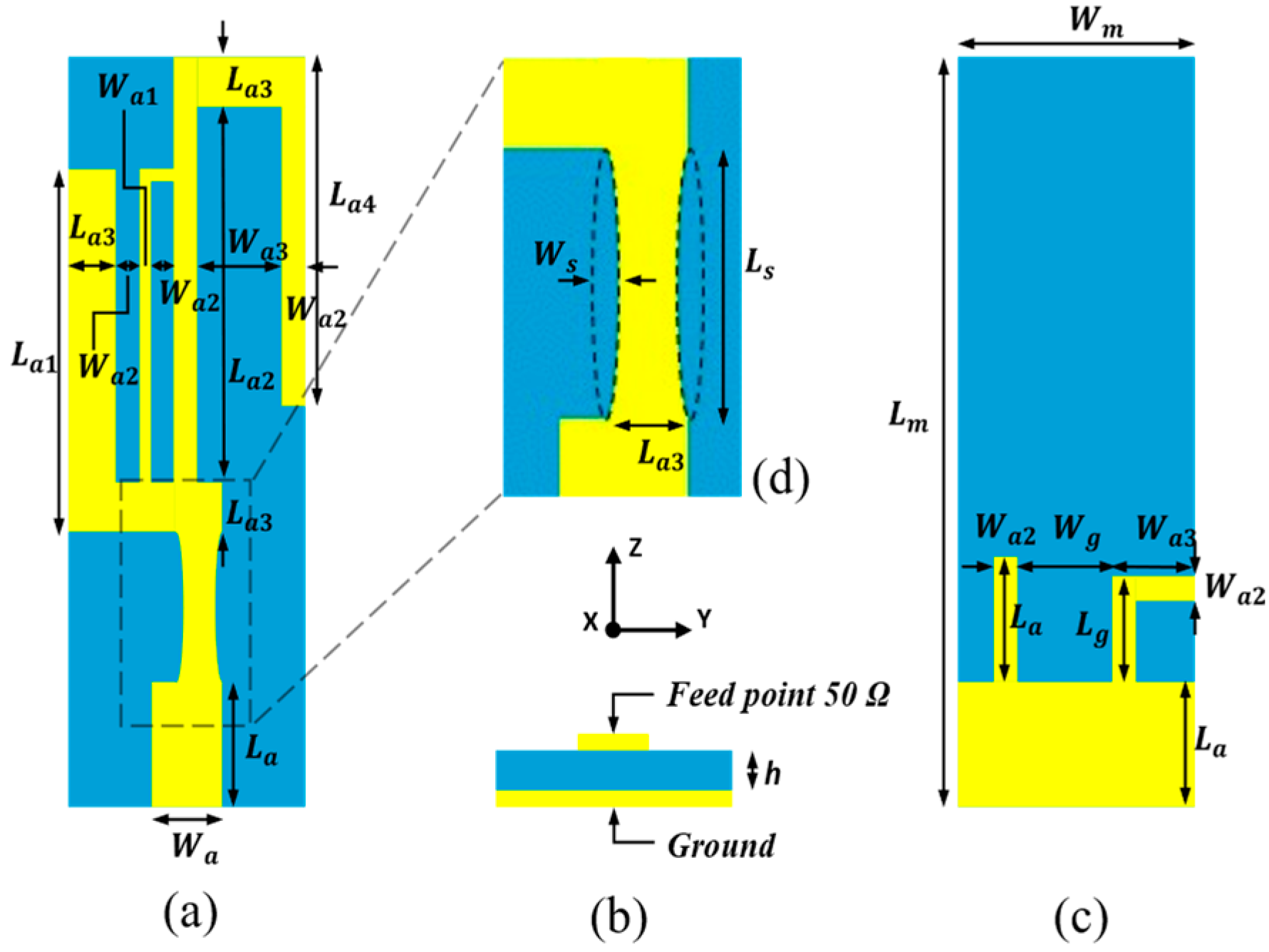
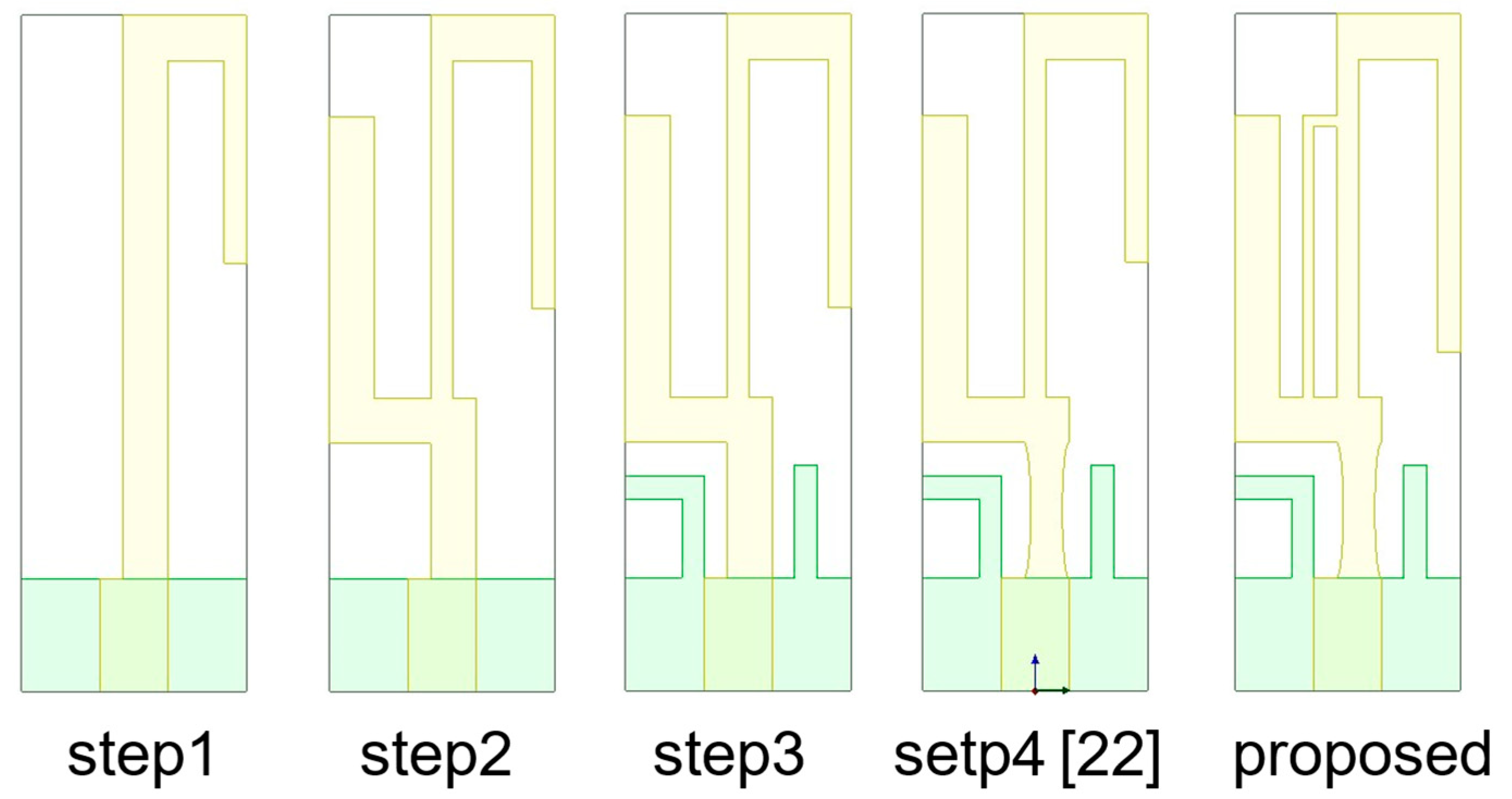
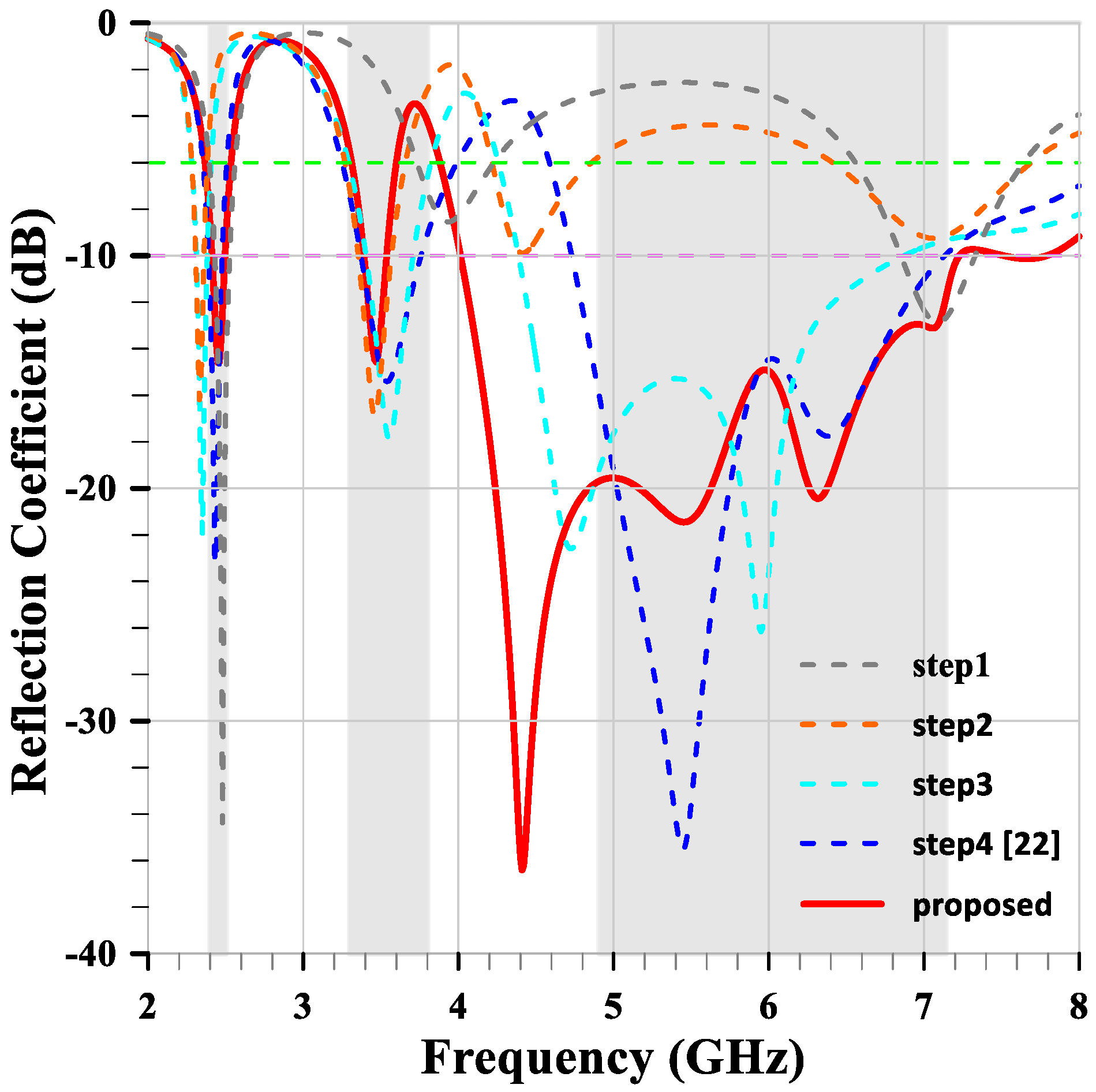
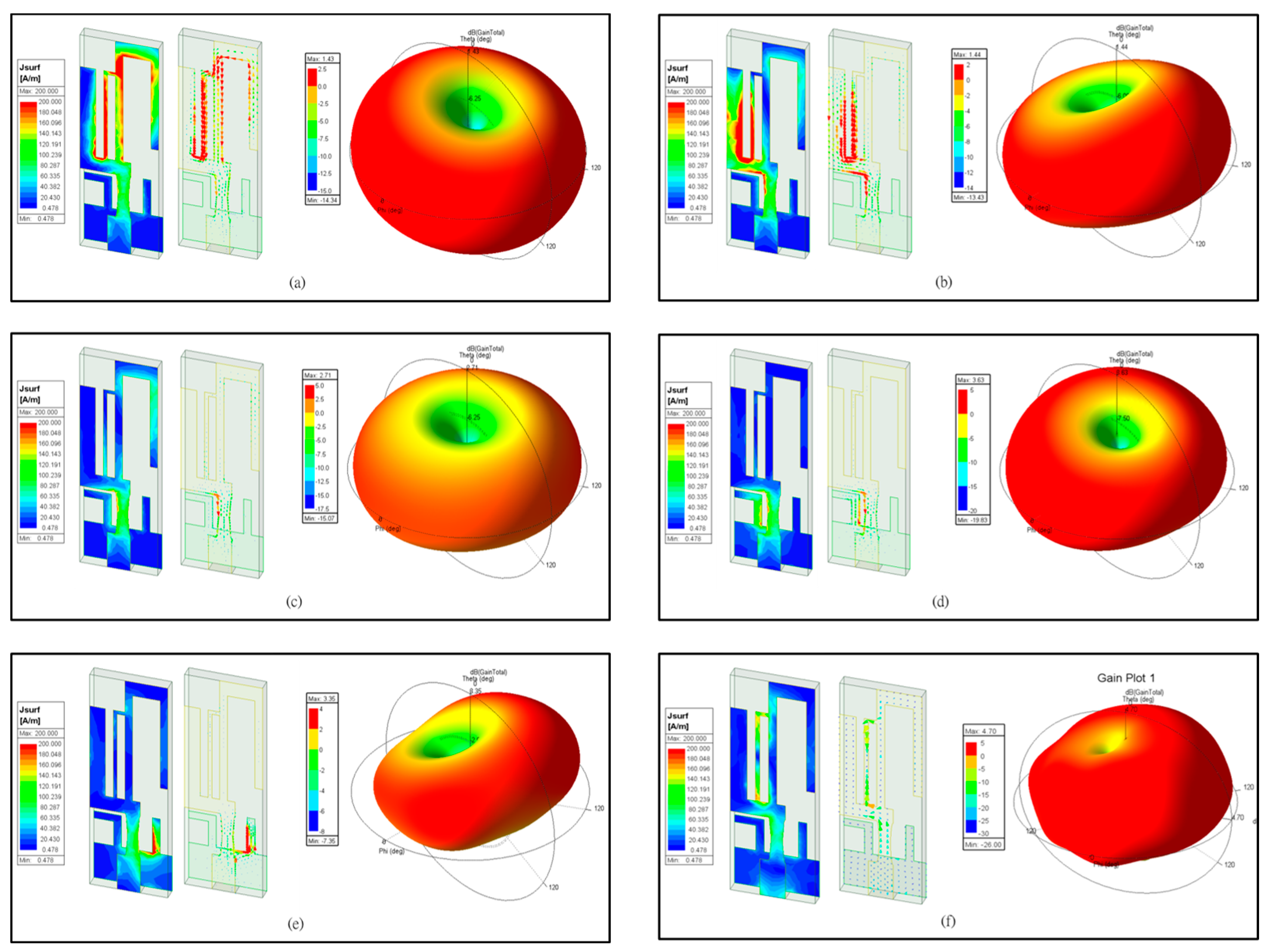



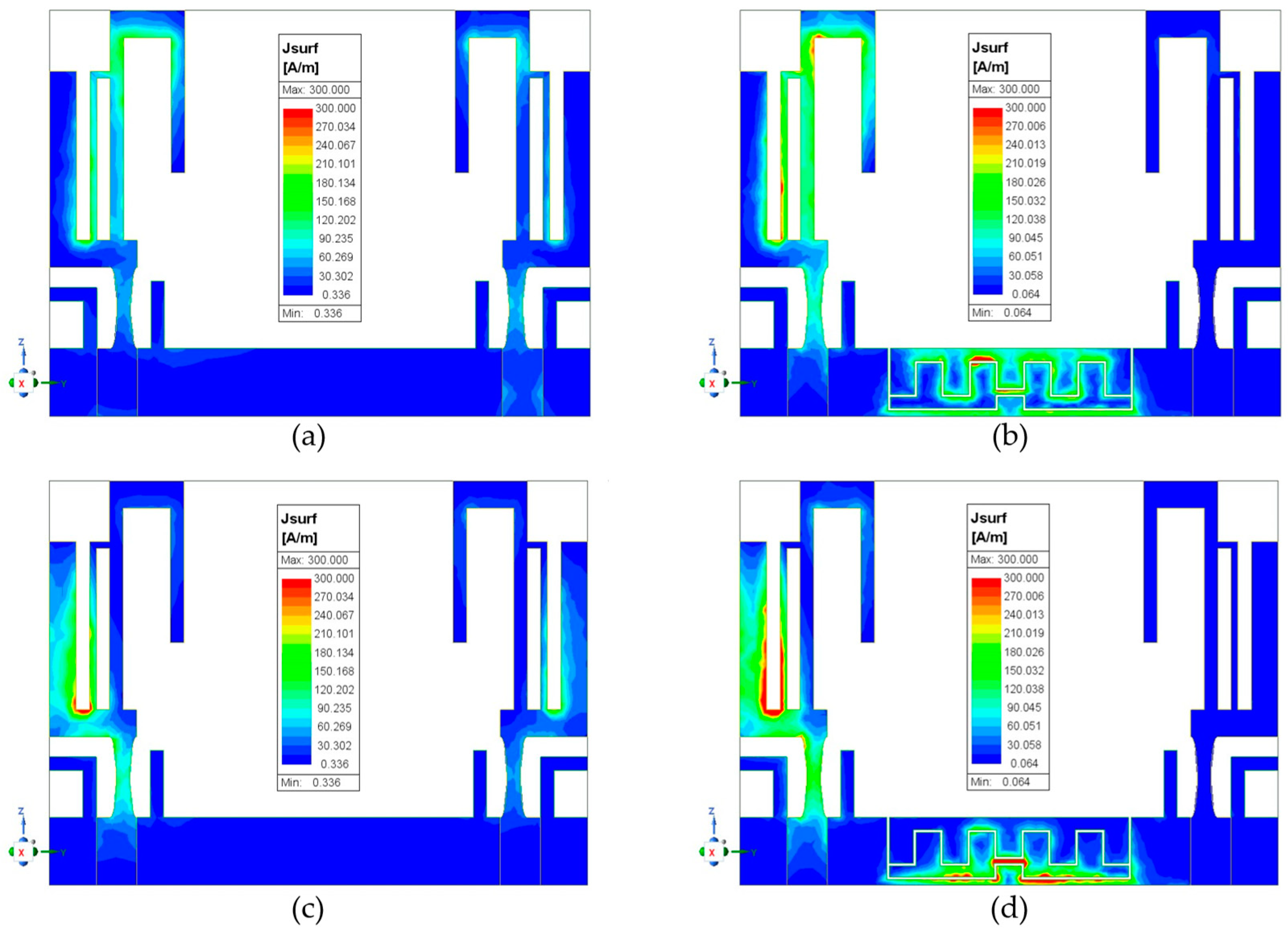



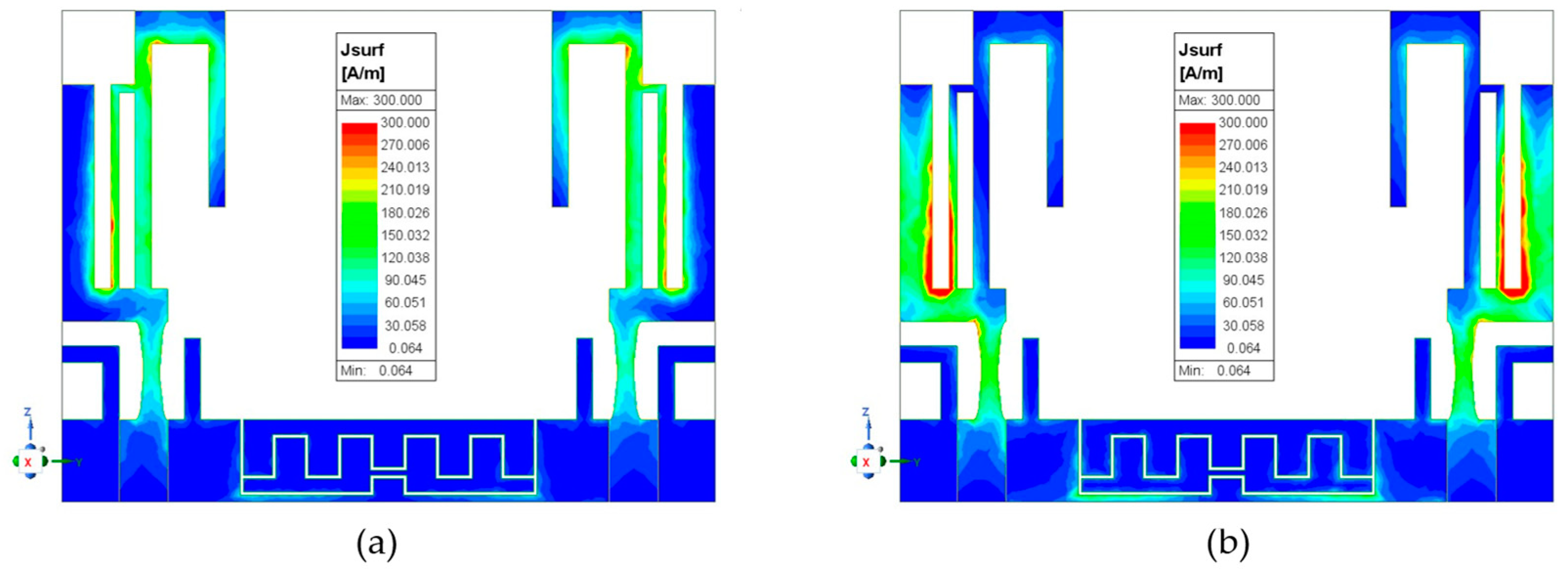

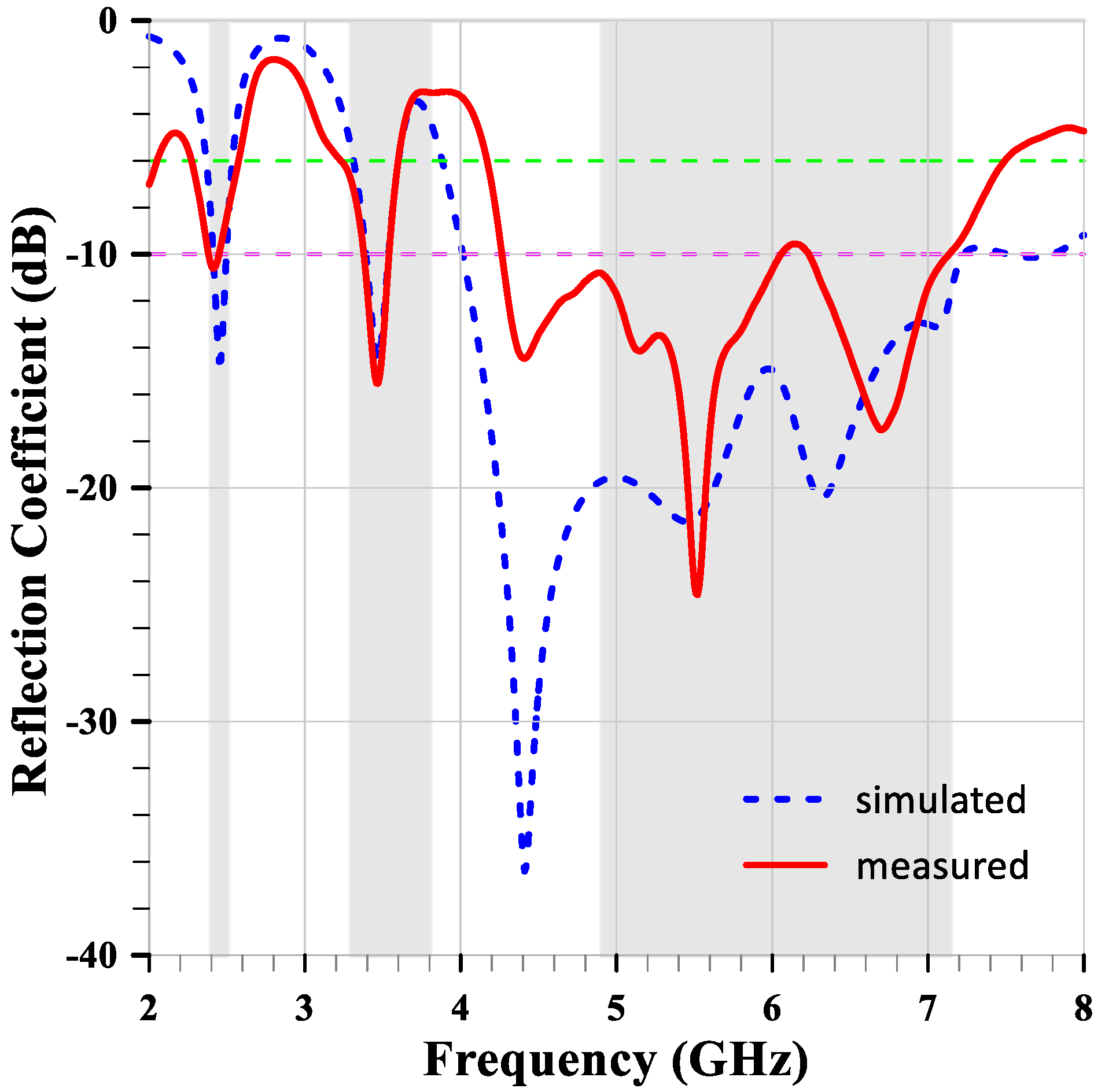
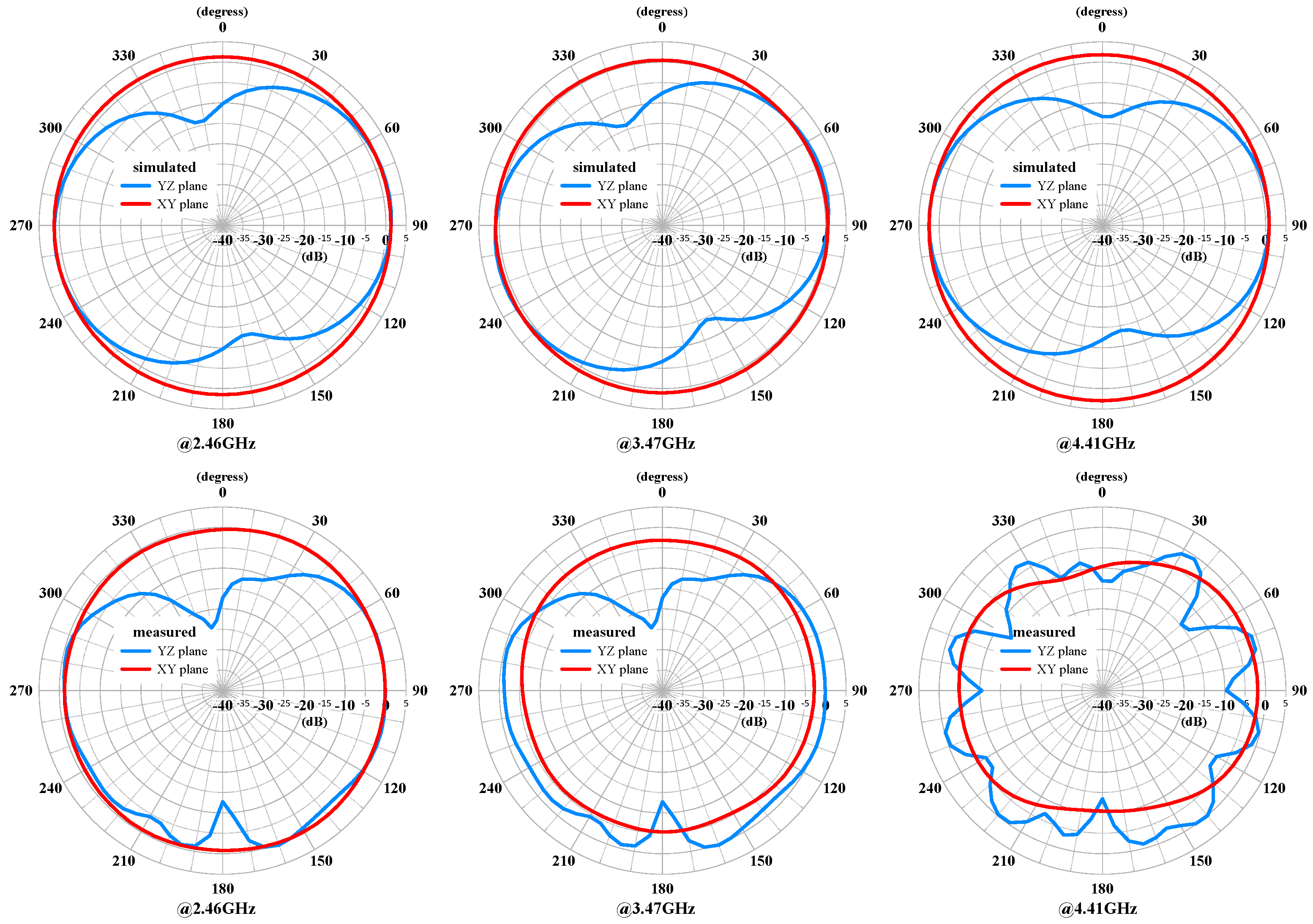
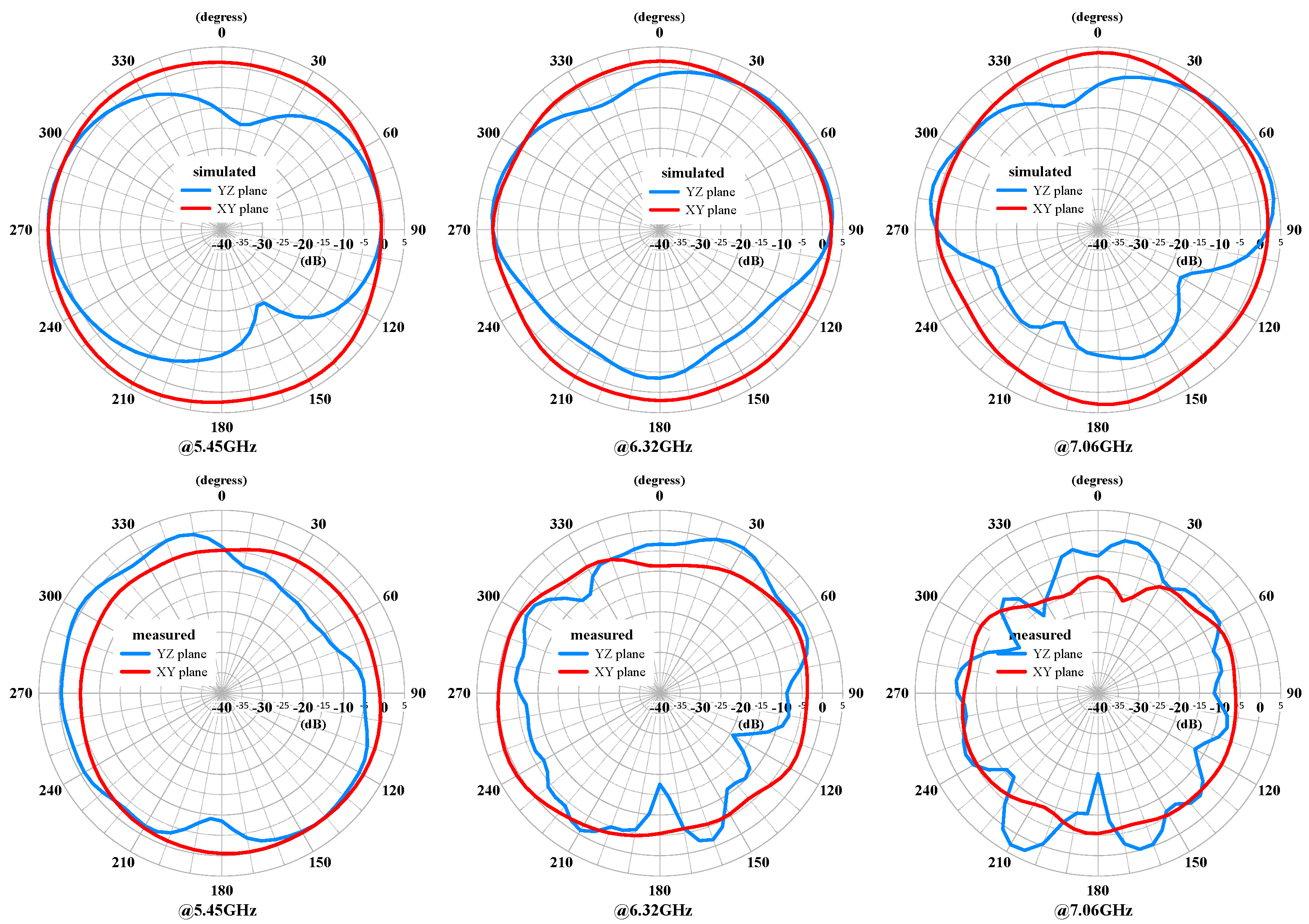



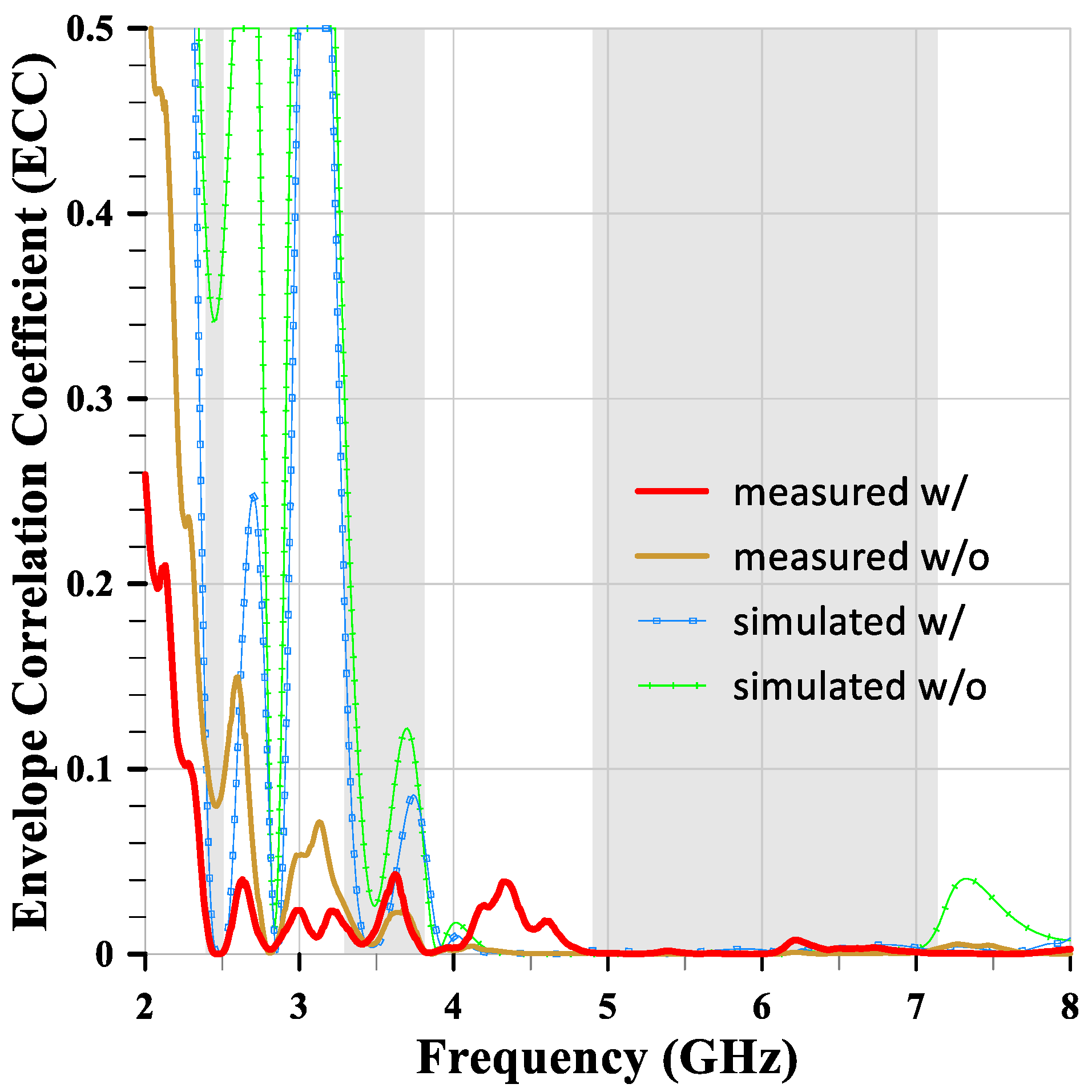
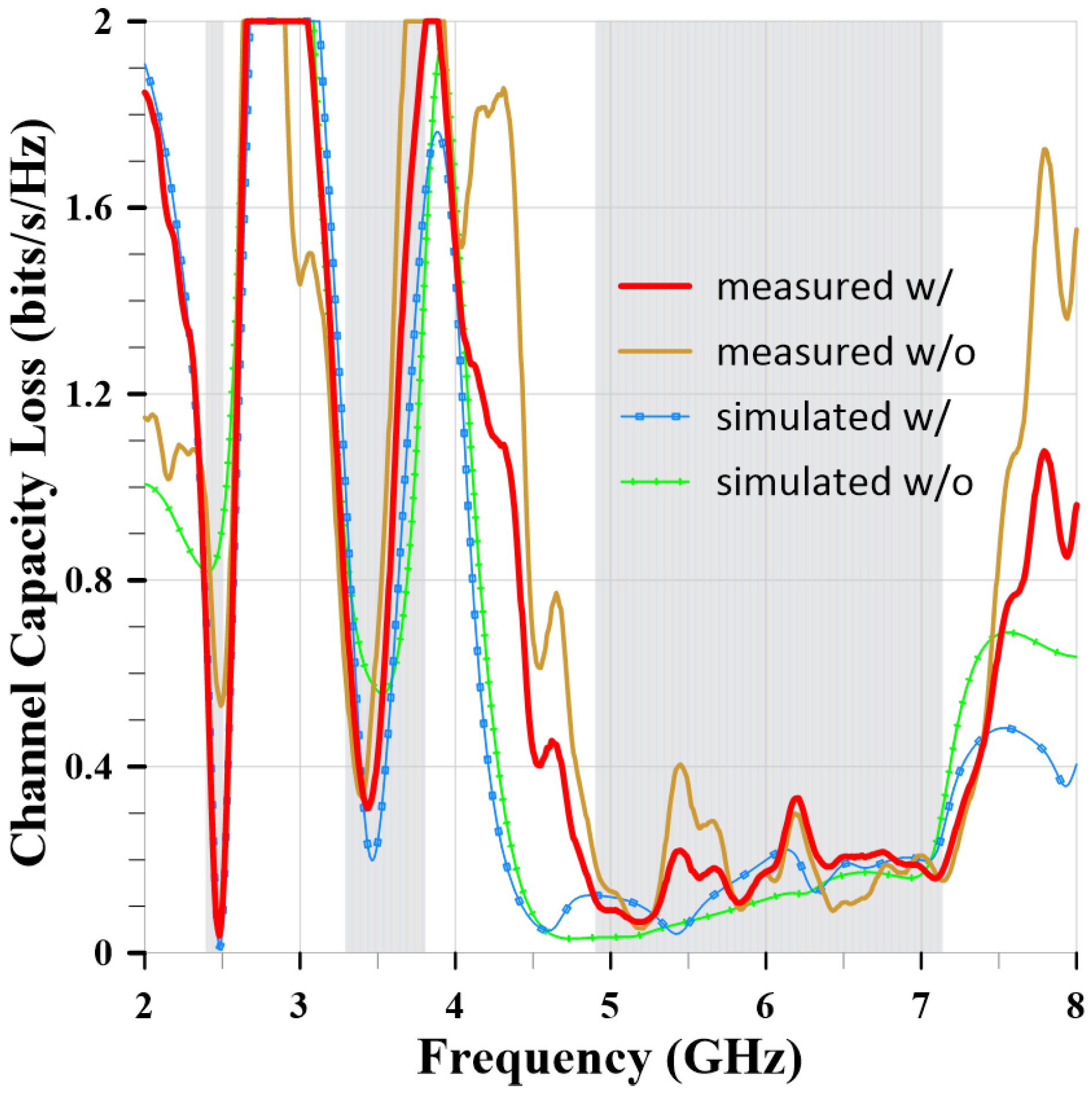
| unit | ||||||||
| 30 | 10 | 5 | 14.5 | 15 | 2 | 11 | 3 | |
| h | mm | |||||||
| 0.5 | 1 | 3.5 | 6 | 0.6 | 4.5 | 4 | 1.6 |
| Ref. | Decoupling Method | Isolation (dB) | ECC | Designable Suppression Frequencies (GHZ) | Add Components | No. of Antennas | |
|---|---|---|---|---|---|---|---|
| This paper | 30 × 40 × 1.6 | DGS | −26, −13 | <0.04 | 2.46, 3.47 | x | 2 monopoles |
| [21] | x | Hilbert-shaped WG-MTM | −21.4 | x | 3.5 | x | 2 patches |
| [20] | x | CSRs WG-MTM | −22.86 | x | 3.5 | x | 2 patches |
| [19] | 40 × 58.3 × 4.75 | H-RRs MTM | −30 | <0.14 | 5.9 | v | 2 patches |
| [18] | 66 × 66 × 0.13 | Pol. direction | <−20 | <0.005 | x | x | 4 dipoles |
| [17] | 41 × 41 × 1.6 | Pol. direction and DGS | −21 | 0.032 | x | x | 4 monopoles |
| [13] | 90 × 40 × 0.79 | neutralization lines | <−17 | <0.005 | x | x | 2 monopoles |
| [12] | 36 × 18 × 1.6 | T-shaped stub | <−18 | <0.006 | x | x | 2 monopoles |
| [8] | x | Insulator | −29 | x | 5 | x | 2 patches |
Disclaimer/Publisher’s Note: The statements, opinions and data contained in all publications are solely those of the individual author(s) and contributor(s) and not of MDPI and/or the editor(s). MDPI and/or the editor(s) disclaim responsibility for any injury to people or property resulting from any ideas, methods, instructions or products referred to in the content. |
© 2024 by the authors. Licensee MDPI, Basel, Switzerland. This article is an open access article distributed under the terms and conditions of the Creative Commons Attribution (CC BY) license (https://creativecommons.org/licenses/by/4.0/).
Share and Cite
Lin, C.-K.; Lin, D.-B.; Lin, H.-C.; Lin, C.-C. Design of a Compact Multiband Monopole Antenna with MIMO Mutual Coupling Reduction. Sensors 2024, 24, 5495. https://doi.org/10.3390/s24175495
Lin C-K, Lin D-B, Lin H-C, Lin C-C. Design of a Compact Multiband Monopole Antenna with MIMO Mutual Coupling Reduction. Sensors. 2024; 24(17):5495. https://doi.org/10.3390/s24175495
Chicago/Turabian StyleLin, Chang-Keng, Ding-Bing Lin, Han-Chang Lin, and Chang-Ching Lin. 2024. "Design of a Compact Multiband Monopole Antenna with MIMO Mutual Coupling Reduction" Sensors 24, no. 17: 5495. https://doi.org/10.3390/s24175495





